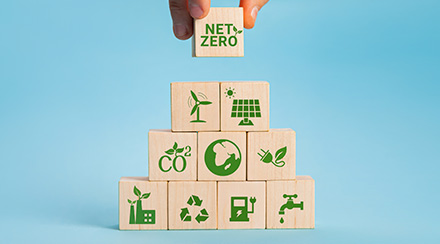What Is Biomass Energy?

Our energy supply comes from a mix of sources, and you probably already know several of them: coal, natural gas, nuclear, wind and solar, just to name a few. But there’s another energy source – biomass – that isn’t always so familiar.
If you’ve ever built a campfire, you’ve used biomass energy. All biomass energy is derived from plants and animals, and wood burning is one of the oldest tried-and-true applications of this energy category. But there’s much more to biomass energy than that.
From its humble beginnings as a fuel source for mankind’s first campfires, biomass energy has evolved into a diverse, high-tech industry in the 21st century. Biomass energy is used to generate electricity, create liquid fuels for vehicles and machines, produce methane and other useful gases, and in many other modern applications.
Because biomass energy comes from organic materials that are part of our natural carbon cycle, it’s a form of renewable energy. And with the careful application of modern methods, biomass has become an important pillar of our cleaner energy future.
Examples of Biomass Energy
The biomass energy in today’s energy mix comes from all sorts of sources, including:
- Wood and wood-based industrial byproducts, such as wood chips and sawdust
- Crops that are cultivated specifically for use as biofuel, like corn and soybeans
- Algae and seaweed
- Byproducts of industries that process animals for food or other products
- Methane gas captured from decomposing garbage in landfills
- Animal manure and human waste from sewage processing plants
Some of these sources, particularly wood, can be burned to create direct heat for warmth, cooking and water heating. And in some developing countries, this is still the most common method for fulfilling these needs. But all of these energy sources can be used in industrial and utility-scale processes to generate energy for modern uses.
Electricity is generated from biomass sources by burning organic material to heat liquid in a boiler, producing steam. The steam then flows through a series of turbines that rotate, powering a generator that produces electricity.
Another modern process involves storing animal and human waste in sealed vessels called digesters, where decomposing materials produce methane and other gases. These gases can then be used to generate electricity as described above, or to produce liquid fuels, fertilizers or a variety of chemical products.
There are also several methods for using heat or chemical decomposition to break down biomass sources into liquid fuels, some of which can be used interchangeably with diesel or gasoline. Common fuels like ethanol and biodiesel are used in this way to reduce the carbon output of internal combustion engines and other machinery.

Advantages of Biomass Energy
Biomass energy offers benefits that are increasingly important as we work to reduce our dependence on fossil fuels and combat climate change. Here are some of its most important advantages:
- Biomass energy is renewable and based on plentiful organic materials
- Some of the most powerful biomass sources can be cultivated quickly using proven methods, making biomass a reliable energy category
- Biomass energy production reduces waste and slows the growth of landfills
- Plant-based biomass sources capture carbon while they grow, so even though they release this carbon upon consumption, they are virtually carbon neutral
- When substituted for fossil fuel energy, biomass energy helps reduce greenhouse gas emissions and slows the effects of climate change
Disadvantages of Biomass Energy
Of course, there are also a few disadvantages to biomass energy. Many biomass sources must be planted, nurtured, harvested and transported at considerable expense, making biomass more expensive than some other renewable energy sources. The biomass materials themselves also take up lots of space at utility scale, which can limit where biomass energy is produced. And because unchecked biomass energy production can result in problems like deforestation or competition with food-related agriculture, it must be carefully managed.
But despite these challenges, biomass energy is a useful and growing part of our overall energy mix. It's something to think about the next time you're toasting marshmallows over the campfire!
Looking for Something Specific?
Select a category to find resources for topics that interest you.
Select Category

Related Articles:

What Are Carbon Offsets?
Carbon offsets help account for the carbon emissions produced by your daily activities. These offsets go toward projects that have a positive impact on the environment, like reforestation or renewable energy production.
Read Article
What Is Renewable Energy, or Clean Energy?
It’s easy to think of renewable energy as cutting edge; we often associate it with solar panels and wind farms, and consider it to be the future of energy production. But this is only partially true.
Read Article
What is a Carbon Footprint and How to Reduce It
We all know some basic steps we can take to safeguard the environment, but some of the most significant changes we can make involve the way we use energy at home.
Read ArticleWhat Is Biomass Energy?
Our energy supply comes from a mix of sources, and you probably already know several of them: coal, natural gas, nuclear, wind and solar, just to name a few. But there’s another energy source – biomass – that isn’t always so familiar.
If you’ve ever built a campfire, you’ve used biomass energy. All biomass energy is derived from plants and animals, and wood burning is one of the oldest tried-and-true applications of this energy category. But there’s much more to biomass energy than that.
From its humble beginnings as a fuel source for mankind’s first campfires, biomass energy has evolved into a diverse, high-tech industry in the 21st century. Biomass energy is used to generate electricity, create liquid fuels for vehicles and machines, produce methane and other useful gases, and in many other modern applications.
Because biomass energy comes from organic materials that are part of our natural carbon cycle, it’s a form of renewable energy. And with the careful application of modern methods, biomass has become an important pillar of our cleaner energy future.
Examples of Biomass Energy
The biomass energy in today’s energy mix comes from all sorts of sources, including:
- Wood and wood-based industrial byproducts, such as wood chips and sawdust
- Crops that are cultivated specifically for use as biofuel, like corn and soybeans
- Algae and seaweed
- Byproducts of industries that process animals for food or other products
- Methane gas captured from decomposing garbage in landfills
- Animal manure and human waste from sewage processing plants
Some of these sources, particularly wood, can be burned to create direct heat for warmth, cooking and water heating. And in some developing countries, this is still the most common method for fulfilling these needs. But all of these energy sources can be used in industrial and utility-scale processes to generate energy for modern uses.
Electricity is generated from biomass sources by burning organic material to heat liquid in a boiler, producing steam. The steam then flows through a series of turbines that rotate, powering a generator that produces electricity.
Another modern process involves storing animal and human waste in sealed vessels called digesters, where decomposing materials produce methane and other gases. These gases can then be used to generate electricity as described above, or to produce liquid fuels, fertilizers or a variety of chemical products.
There are also several methods for using heat or chemical decomposition to break down biomass sources into liquid fuels, some of which can be used interchangeably with diesel or gasoline. Common fuels like ethanol and biodiesel are used in this way to reduce the carbon output of internal combustion engines and other machinery.
Advantages of Biomass Energy
Biomass energy offers benefits that are increasingly important as we work to reduce our dependence on fossil fuels and combat climate change. Here are some of its most important advantages:
- Biomass energy is renewable and based on plentiful organic materials
- Some of the most powerful biomass sources can be cultivated quickly using proven methods, making biomass a reliable energy category
- Biomass energy production reduces waste and slows the growth of landfills
- Plant-based biomass sources capture carbon while they grow, so even though they release this carbon upon consumption, they are virtually carbon neutral
- When substituted for fossil fuel energy, biomass energy helps reduce greenhouse gas emissions and slows the effects of climate change
Disadvantages of Biomass Energy
Of course, there are also a few disadvantages to biomass energy. Many biomass sources must be planted, nurtured, harvested and transported at considerable expense, making biomass more expensive than some other renewable energy sources. The biomass materials themselves also take up lots of space at utility scale, which can limit where biomass energy is produced. And because unchecked biomass energy production can result in problems like deforestation or competition with food-related agriculture, it must be carefully managed.
But despite these challenges, biomass energy is a useful and growing part of our overall energy mix. It's something to think about the next time you're toasting marshmallows over the campfire!
Looking for Something Specific?
Select a category to find resources for topics that interest you.
Select Category

Related Articles:

What Are Carbon Offsets?
Carbon offsets help account for the carbon emissions produced by your daily activities. These offsets go toward projects that have a positive impact on the environment, like reforestation or renewable energy production.
Read Article
What Is Renewable Energy, or Clean Energy?
It’s easy to think of renewable energy as cutting edge; we often associate it with solar panels and wind farms, and consider it to be the future of energy production. But this is only partially true.
Read Article
What is a Carbon Footprint and How to Reduce It
We all know some basic steps we can take to safeguard the environment, but some of the most significant changes we can make involve the way we use energy at home.
Read Article






